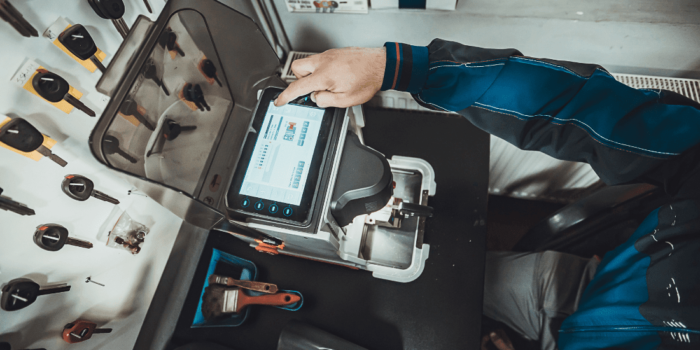Digital car keys promise a lot but can carry a lot of risks. Knowing the pros and cons can help your customers to decide which is the better option.
The Evolution Of The Car Key
Car keys have changed considerably over the years, from primitive metal blades that can be easily recut, to complex transponder keys that can only be reproduced with a specialist car key programmer.
In this article, we’ll explore the fascinating history of car keys, from the earliest variants to the modern day.

The First Car Keys
In the early 20th century, cars were still a recent invention, with only 187,000 registered vehicles in the UK. Car keys were no more than simple metal blades designed to slide into the door locks and the ignition; flat, basic, and easy to duplicate, providing minimal security for vehicle owners. However, as car thefts became more prevalent, the automotive industry recognised the need for more sophisticated security technology – a realisation that marked the beginning of the evolution of the car key.
Baby Steps In Vehicle Security
The first significant advance in car key security technology occurred in 1949 when Chrysler introduced key numbering to differentiate between individual keys. As a result, automotive manufacturers began to stamp a unique number code on their keys to make it more difficult for thieves to duplicate them. This marked a crucial step towards enhancing car security, although vehicle security still relied heavily on primitive mechanics that were certainly not foolproof!
Consigning Key Blades To History
The first major revolution in car key technology occurred in 1995 with the development of transponder keys featuring an embedded electronic chip that communicated with the car’s immobiliser. When the key was inserted into the ignition, the chip transmitted a unique signal to the engine control unit, allowing the engine to start only if it recognised the code. Transponder keys significantly reduced car thefts, as the engine wouldn’t start even if a thief managed to create a physical copy of the key without the correct chip.
The introduction of vehicle immobilisers and transponder keys caused car crime in the UK to plummet as by 2016, incidents had dropped by approximately 80 per cent.
A Keyless Experience
As vehicle security technology continued to advance, keyless entry systems emerged in the early 21st century, offering greater convenience to car owners. Key fobs or proximity sensors allowed the car to detect the presence of the key nearby, enabling remote unlocking and starting. No longer did car owners have to physically insert the key to unlock or start the vehicle, making the whole process effortless – a real bonus in rainy weather or if the motorist’s hands were full!
When Car Keys Became Smart
The next leap in the evolution of car keys came with the advent of smart keys and mobile apps. Introduced in 2022, these keys use wireless technologies to allow motorists to lock, unlock, and start their cars using dedicated smartphone apps. Smart keys communicate with the car’s onboard computer system, enabling seamless interactions between the user and the vehicle. With just a few taps on their mobile devices, car owners can perform various functions, such as adjusting climate settings, checking fuel levels, and locating their vehicles in a crowded car park.
Furthermore, smart key apps can be customised to allow multiple users to access the same vehicle with unique settings for each driver, adding a layer of personalisation and convenience.
Smart key technology opens up possibilities for integrating with other smart devices and services, paving the way for a more connected driving experience.
Contact Us To Find Out More
To find out more about our comprehensive range of wholesale key fobs, transponders, and car key programmers, please get in touch today.

Image Source: Canva



